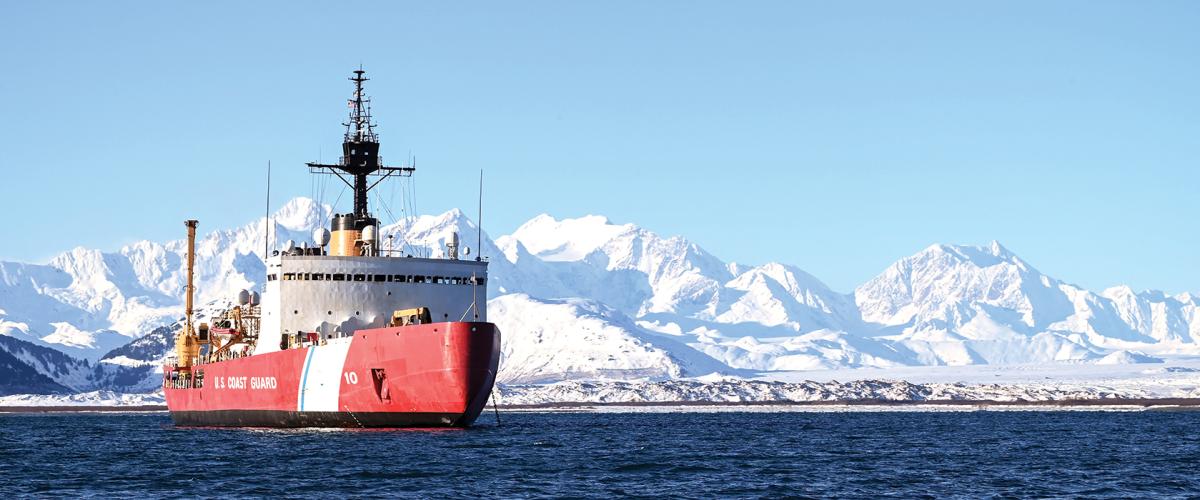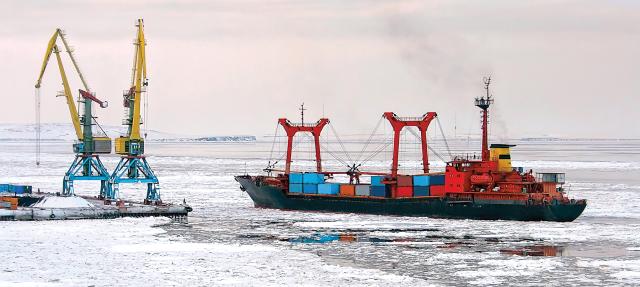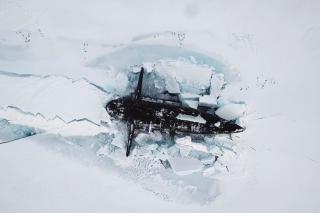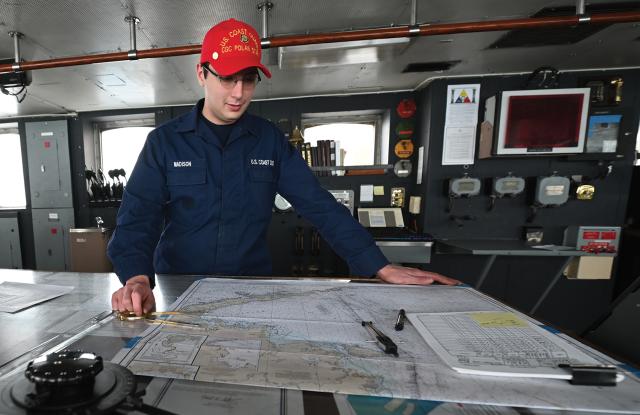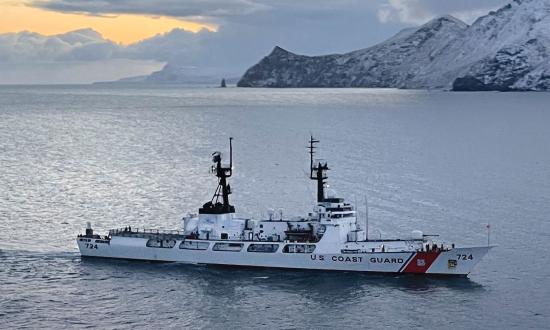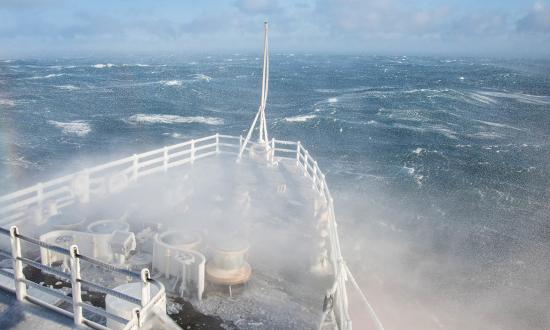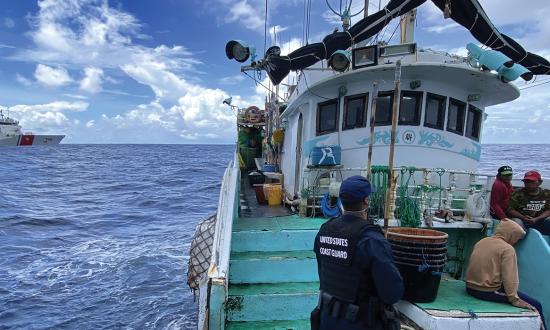The writing is on the glacier wall for the Arctic. “Polar issues” are here to stay, and the region’s growing geopolitical significance presents both opportunities and threats. It is imperative the United States continues to invest in Arctic capabilities—and the focal point of this investment should be a U.S. Arctic Command (ArcticCom). A new combatant command (CoCom) will ensure a coherent national strategy and unity of effort in meeting emerging challenges above the Arctic Circle. The Coast Guard is the military service best suited to lead such a command, but it will require a new Coast Guard four-star admiral billet to serve as ArcticCom’s commander.
What’s at Stake
The value of access to the Arctic has been well documented. The Northern Sea Route is beginning to change international shipping and tourism. The region may be awash with hydrocarbon reserves—as much as 90 billion barrels of oil, 1,669 trillion cubic feet of natural gas, and 44 billion barrels of natural gas liquids.1 Minerals, too, exist in plenty—manganese, copper, nickel, cobalt, diamonds, gold, and others—not to mention untapped fishing resources.
Established in 1996, the Arctic Council is the primary diplomatic forum for tackling international challenges there. Its eight members (Canada, Denmark, Finland, Iceland, Norway, Russia, Sweden, and the United States) all possess sovereign Arctic territory, and all have vested diplomatic and economic interests in the region’s future development. The United States has enjoyed long-standing partnerships with many of these member states, but Russia’s (and China’s) current and emerging capabilities create serious military, diplomatic, and economic concerns.
Russia’s robust fleet of more than 40 icebreakers and its developing port and transportation infrastructure along its northern coastline signal its intent to exploit the region’s rich natural resources. Russian Arctic military bases and assets create concern as well. The March Umka-2021 military exercise—in which three ballistic-missile submarines broke through the ice—was part of a coordinated and public show of force.2
China, too, has been signaling interest in expanding influence in the region. Beijing certainly has the incentive to do so. A trip from Shanghai to Hamburg by the Northern Sea Route is 40 percent shorter—3,000 miles less—than going by way of the Indian Ocean.3 A Polar Silk Road through the Northern Sea Route would reduce China’s economic and military vulnerabilities in maritime chokepoints such as the Strait of Malacca and Suez Canal. Chinese President Xi Jinping has declared China to be a “polar great power,” and a 2018 white paper proclaimed China a “near-Arctic state.” 4
Militarily, Chinese and Russian strategic nuclear strike capabilities pose security challenges. Antisubmarine warfare in the high latitudes is extremely challenging because pack ice can conceal submarines from satellites and acoustic detection systems. Arctic-based submarines could launch missiles with little early warning, leaving the United States vulnerable to nuclear attack.3
The Need for U.S. Arctic Command
The 1986 Goldwater-Nichols Department of Defense Reorganization Act streamlined the U.S. military’s structure to ensure unity of effort among the armed services. Operationally, the world is divided into geographic theaters under the leadership of regional combatant commanders, who plan and execute operations within the theaters using forces from all the services. CoComs report directly to the Secretary of Defense under the direction of the President. The 2011 Unified Command Plan established 11 geographic and functional CoComs and divided Arctic responsibilities between the U.S. European and Northern Commands (EuCom and NorthCom).5
As a whole, the Arctic region extends well beyond EuCom’s geographic scope. The 2015 European Command Theater Strategy listed its top two priorities as “Deter Russian Aggression” and “Enable the NATO Alliance.”6 The theater strategy lists a myriad of security concerns throughout its vast geography, ranging from migrant and refugee flow across the Mediterranean to Russian aggression along NATO’s Eastern European borders. These challenges will warrant EuCom’s undivided attention for years to come.
NorthCom has responsibility over the portion of the Arctic Circle that includes Alaska, Canada, and the Northwest Passage. But NorthCom is mainly responsible for defense of the homeland and security issues along the U.S. continental northern and southern borders; the Arctic is only one among a labyrinth of security concerns. Neither NorthCom, EuCom, nor Indo-Pacific Command (which had some responsibility for the Arctic prior to 2011) is especially well suited to navigate the expanding range of Arctic challenges on its own.
This shared responsibility model was adequate for a region largely unexplored, thinly inhabited, and inaccessible much of the time, and the risk of armed conflict there has been relatively low. However, melting ice caps are quickly and drastically changing the Arctic’s geopolitical landscape. The United States must adapt to this dynamic with a focused new model.
Precedents exist for establishing additional CoComs when new warfighting domains emerge. Cyber Command and Space Command were established to synchronize joint force commanders in operations global in scope. As SpaceCom Commander Army General James Dickinson remarked in 2020: “Space is a warfighting domain, not because we want it to be, but because our adversaries have seen the advantages that space has provided to our way of life and our way of war.”7 The same is true of the Arctic. U.S. adversaries and partners alike will capitalize on the opportunities the Arctic presents, and the United States must be prepared to enhance and preserve its interests there. ArcticCom should become the 12th CoCom.
The Coast Guard in ArcticCom
National Security Presidential Directive–66, dated 9 January 2009, establishes six Arctic policy objectives for the United States: (1) Meet national security and homeland security needs relevant to the Arctic region; (2) protect the Arctic environment and conserve its biological resources; (3) ensure that natural resource management and economic development in the region are environmentally sustainable; (4) strengthen institutions for cooperation among the eight Arctic nations; (5) involve the Arctic’s indigenous communities in decisions that affect them; and (6) enhance scientific monitoring and research into local, regional, and global environmental issues.8 These objectives align closely with five of the Coast Guard’s statutory missions: living marine resources, marine safety, aids to navigation, defense readiness, and search and rescue.
The Arctic’s early-stage development will require international agreements to tackle challenges associated with a growing commercial and military maritime presence. The United States must collaborate with international partners to establish port and waterways infrastructure development, environmental protection frameworks, oil-spill response plans, and joint emergency response systems. It will benefit the nation to employ soft power in the Arctic to cultivate international relationships while protecting national interests.
A robust Coast Guard presence is often perceived as a less aggressive posture than naval or other service activities. The service’s multimission capabilities and law enforcement authorities make it especially suited for promoting interagency and international relations. This doubtless played a role in President Barack Obama appointing former Coast Guard Commandant Admiral Robert Papp to be the U.S. Special Representative to the Arctic Council. And who better to forge diplomatic partnerships in the Arctic than a military leader with an intimate understanding of the challenges and opportunities the region presents?
Increased private-sector polar presence in the form of mining, cargo shipping, fishing, and port infrastructure development will require a concomitant increase in Coast Guard capabilities. The service currently operates two icebreakers in the polar regions. According to a 2013 Department of Homeland Security (DHS) Mission Needs Statement, the Coast Guard needs to expand its ice operation capacity with a fleet of at least six icebreakers to meet mission demands in the high latitudes.9 The Coast Guard has already taken steps to recapitalize its aging icebreaker fleet, awarding the contract for the new polar security cutter class to VT Halter Marine of Pascagoula, Mississippi. Construction has begun, with anticipated delivery in 2024.10 On this expansion trajectory, the Coast Guard will continue to be the most seasoned and experienced armed service in the Arctic region in the decades to come.
ArcticCom Actual
A key tenet of the “joint” military is that combatant commanders can originate from any of the armed services. They are selected by the Joint Chiefs of Staff, nominated by the President, and confirmed by the Senate. There has never been a Coast Guard officer selected as a combatant commander. But given the Coast Guard’s expertise in the high latitudes, a Coast Guard admiral with polar experience would be best suited to lead ArcticCom.
There are only two major obstacles. First, CoComs must be four-star flag officers, but the Coast Guard is allowed only two four-star admirals by law: the Commandant and Vice Commandant. Congress could authorize an additional admiral billet, however, as it did in 2015, when it upgraded the Vice Commandant billet from a three- to four-star officer to achieve parity with the other services.11 While the Coast Guard is a part of DHS, not DoD, Congress can remove or modify any legal barriers to a non-DoD flag officer serving in a combatant commander position.
Second, and more challenging, is the service’s glaring absence from membership on the Joint Chiefs of Staff, and it would be naïve to assume that interservice politics do not play a role in the selection of CoCom leaders. However, no crystal ball exists to determine the future political landscape within the Joint Chiefs or the political capital that a future admiral will possess. (Legislation was proposed in March to give the Coast Guard Commandant voting membership on the Joint Chiefs, but so far the bill has not advanced.) The Coast Guard’s growing role in the Arctic coupled with key “Coast Guard friendly” influencers in the White House can easily bring the smallest Sea Service into the conversation for appointment to a leadership position.
The Coast Guard has long been at the forefront of U.S. presence in the Arctic. The United States must invest in the Arctic region if it is to preserve its sovereign interests while competing with an expanding number of international stakeholders. Establishing ArcticCom will enable the country to pursue a unified national strategy in developing and executing Arctic operations. As former Defense Secretary James Mattis astutely declared in 2018, “America has got to up its game in the Arctic. . . . Part of it will certainly [be] an increased Coast Guard presence.”12 The Coast Guard’s investments in the polar security cutter and execution of its missions in the high latitudes are a good start, but making a Coast Guard admiral a combatant commander for the Arctic will allow the United States to lead in developing the Arctic frontier.
1. ADM David Gove, USN, “Arctic Melt: Reopening a Naval Frontier,” U.S. Naval Institute Proceedings 135, no. 2 (February 2009): 16–21.
2. Joseph Trevithick, “Three Russian Ballistic Missile Submarines Just Surfaced through the Arctic Ice Together,” The War Zone, 26 March 2021.
3. Anne-Marie Brady, China as a Polar Great Power (Cambridge, UK: Cambridge University Press, 2017), 65.
4. Brady, China as a Polar Great Power, 3; Rebecca Hersman, Eric Brewer, and Maxwell Simon, “Deep Dive Debrief: Strategic Stability and Competition in the Arctic,” CSIS Briefs, 6 January 2021, 2.
5. Andrew Feickert, “The Unified Command Plan and Combatant Commands: Background and Issues for Congress,” Congressional Research Service, 3 January 2013.
6. Gen. Philip M. Breedlove, USAF, United States European Command Theater Strategy, Department of Defense, October 2015.
7. Kimberly Underwood, “New Leader Takes Over Space Command,” Signal, 21 August 2020.
8. The White House, National Security Presidential Directive and Homeland Security Presidential Directive: NSPD-66/HSPD-25, 9 January 2009.
9. Department of Homeland Security, Polar Icebreaking Recapitalization Project Mission Need Statement, 28 June 2013, 9.
10. Ronald O’Rourke, Coast Guard Polar Security Cutter (Polar Icebreaker) Program, Congressional Research Service, 14 January 2021, 7.
11. U.S. Congress, H.R.4188—Coast Guard Authorization Act of 2015, 8 February 2016.
12. Secretary of Defense James N. Mattis, “Press Conference by Secretary Mattis and Sen. Sullivan in Alaska,” 26 June 2018.



